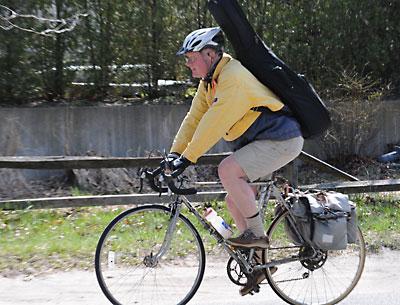A Plan to Share the Roads

The East Hampton Village should modify roads and educate motorists in order to better accommodate bicyclists and pedestrians, according to two residents who addressed the East Hampton Village Board at its work session last Thursday.
Describing roadways as dangerous and the relationship between motorists and bicyclists as “anarchy,” Paul Fiondella and Howard Lebwith suggested adoption of a detailed set of principles that they said would result in safer conditions for bikers and pedestrians.
Mr. Fiondella recalled seeing a yellow Labrador on long-ago morning drives to Bucket’s Deli. The dog was jaywalking across Newtown Lane, “going from one place to the next, mooching his way along, minding his own business, and totally ignoring anything that was going on with automobiles,” he said. Mr. Fiondella, an avid runner and walker, added that “the point has been reached where I don’t feel safe in doing either one. The village has been taken over by automobiles, and it’s very dangerous to be a pedestrian or a bicyclist and go to the village using either method.”
Citing a high incidence of accidents last summer, including one in which a 17-year-old honor student was killed by a taxicab as he walked along Old Stone Highway in Amagansett, Mr. Fiondella said that the proliferation of automobiles has “changed the quality of life from when a yellow Labrador could wander down Newtown Lane carefree, to a situation in which humans who want to walk to the village take their life in their hands.”
Seeing little progress on improving safety for bicyclists or pedestrians, Mr. Fiondella presented the board with a document, “General Principles For Introducing Bike Lanes in East Hampton Village,” consisting of definitions and principles he said should govern any future action toward that end. “The whole idea of this proposal is to make it safe for someone to get on a bicycle, come to the village, pick up their groceries, do some shopping, and go home. You don’t necessarily have to take your car unless you feel that any other way would be unsafe,” he said.
The document makes distinctions between bike lanes (sections of paved public roads and highways marked out for the use of bicycles), bike paths (lanes on paved public roads that are physically separated from the automobile lanes), and calm streets (paved local roads where primary automobile use is by residential homeowners to gain access to their property).
Among the principles proposed is that “bike lanes should be located on public roads where they promote an alternative to automobile use and provide local access to major public facilities,” such as schools, beaches, libraries, shopping areas, recreational and government facilities, and transportation hubs. Also, “new bike lanes should be a part of the design of any highway improvement project,” and “wherever possible bike lanes should be placed on the paved shoulder of roads and not in the vehicle travel lanes.” They also proposed an expansion of shoulders, to a minimum width of three feet, in any repaving project.
Mr. Fiondella suggested that the board seek comments from the departments that would be affected by such a project, that it establish a committee to examine the principles, or that it simply adopt the principles after internal discussion.
Mr. Lebwith stressed the need for education of motorists, bicyclists, and pedestrians alike. Most bikers, he said, do not signal, nor do they stop when and where they should, such as at stop signs and red lights. At the same time, he said, motorists are not typically courteous of bicyclists. “Most motorists, when they park their car, just open the door and step out. There have been a number of people in this town that have been injured, badly, by running into a door,” he said.
Mr. Lebwith also showed the board a pamphlet detailing bicycle safety and basic techniques that he said he had developed with East Hampton Town officials, and suggested it be republished.
Mayor Paul F. Rickenbach Jr. told Mr. Fiondella and Mr. Lebwith to set up an informal meeting with Chief Gerard Larsen of the village police and public works officials. “Let’s see if we can achieve some results,” he said.
The board also decided that $100 would be the fee assessed for tent-permit applications, after previously acting to require a fee for such permits.
The town and other neighboring municipalities already impose a fee, Kenneth Collum, the village fire marshal, told the board. Last year, 65 to 75 tent permits were given, he said, following inspections as stipulated by the state’s fire prevention law. “Some of them are very involved,” he said. “Some of these structures are on scaffolding; they need engineering reports.” The fee would offset the time and energy code enforcement officials devote to the inspection and approval process.
Barbara Borsack, a board member, asked that nonprofit organizations be exempted from paying a fee, “but we have to be specific about it,” she said. “It would have to be a nonprofit on their own property doing a fund-raiser for themselves.” Only five or six such applications were received last year, Mr. Collum said.
“Would you be able to differentiate between the two?” Elbert Edwards, of the board, asked Mr. Collum.
“I think so,” Mr. Collum replied. “I don’t think it’s going to be that hard to figure out what they’re doing.”
